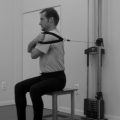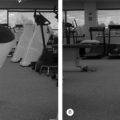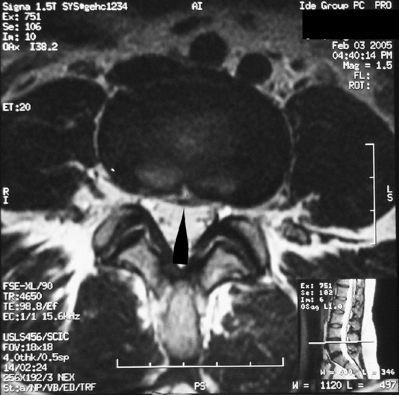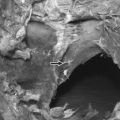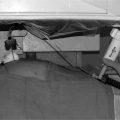CHAPTER 65 Sympathetic System
STELLATE GANGLION BLOCK
Clinical syndrome
‘Sympathetically maintained pain’ is defined as ‘pain that is maintained by sympathetic efferent innervation or by circulating catecholamines (especially norepinephrine).’1 This presents an assumed pain mechanism, not a clinical syndrome, and therefore it can be present in different pain syndromes. The most common places where it occurs are the extremities and the face. Disturbances in the mechanism of the sympathetic system of the face and the upper extremity can give the following symptoms: swelling, hyperhidrosis, disturbances in the temperature regulation of the skin, and changes in skin coloring. There are several diseases and syndromes that can show disturbances in the sympathetic innervation. One example is the complex regional pain syndrome type 1 (CRPS-1) that is characterized by continuing pain after an initiating noxious event or after an immobilization, allodynia, or hyperalgesia with which the pain is disproportionate to any inciting event.2 There is a growing controversy on the value of sympathetic blocks in CRPS-1 and 2. A recent review raises questions on the efficacy of local anesthetic sympathetic blockade as a treatment of CRPS. In this review it was concluded that less than one-third of patients involved in trials obtained full pain relief.3 Further studies are needed to clarify this indication.
Indications and contraindications
Side effects and complications
One of the most serious complications can occur if there is an unintentional injection involving the vertebral and/or the carotid artery,7 as seizures that are difficult to treat will result. Accidental injection intrathecally will lead to respiratory failure and the requirement of mechanical ventilation.8–11 In anticipation of these potential complications, it is advised that an intravenous line be in place prior to the blockade. A less serious but quite disconcerting side effect results from inadvertent diffusion of local anesthetics into nearby nerve structures. In particular, blockade of the recurrent laryngeal nerve typically results in hoarseness, the sensation of a mass in the throat, and sometimes a subjective shortness of breath. Of course, this complication can be dangerous when the blockade has been performed bilaterally in patients with preprocedural respiratory impairment.12 In other instances, a partial blockade of the brachial plexus with temporary paralysis of arm musculature can result.13 If the phrenic nerve is blocked, a temporary unilateral paralysis of the diaphragm transpires with resultant respiratory impairment.14
Outcomes
There are only a handful of published studies regarding the efficacy of a stellate ganglion block. In 1983, Bonelli et al. performed a randomized, controlled trial in patients with reflex sympathetic dystrophy (RSD) of the upper extremity in which they compared the efficacy of stellate ganglion block using 15 ml bupivacaine 0.5%, up to a total of eight blocks, with treatment by a regional intravenous sympathetic block using 20 mg guanethidine every 4 days up to a total of four blocks.15 They concluded that there was a significant improvement in the visual analogue scale (VAS), skin temperature, and skin plethysmography as compared to baseline. There were no significant baseline differences between the two groups. Malmqvist et al. published a randomized controlled trial in 1992 which assessed the efficacy of stellate ganglion blocks using different concentrations and volumes of local anesthetic and different sites of injection.16 They called the sympathetic block ‘complete’ if the following five criteria were met: the presence of a change in skin temperature, skin blood flow, resistance response and skin resistance level, and the symptoms of Horner’s syndrome. They concluded that it is difficult to perform a block that meets all the five criteria since only six of the 54 blocks met all five criteria. They claimed that injection toward C7 (instead of injection toward C6) and a high concentration were more likely to achieve a successful block. The volume seemed of less importance.
There has been only one study performed addressing RF lesioning of the stellate ganglion for the treatment of pain in the upper extremity caused by RSD.17 It was a poorly designed retrospective study.
In 1998, Price et al. published a study with a small number of participants in which they compared the efficacy of a sympathetic ganglion block using 1% lidocaine/bupivacaine and a block with normal saline in patients with CRPS-1 using a double-blinded, cross-over paradigm.18 Four of the seven patients received a stellate ganglion block, and three received a lumbar sympathetic block. In both the local anesthetic group and the saline group there was a large reduction in pain relief accompanied by the reversal of mechanical allodynia 30 minutes after the block in six in of the seven patients. There was no significant difference in the initial peak reduction between the groups. The mean duration of pain relief was significantly longer in the local anesthetic group. The authors concluded that both magnitude and duration of pain relief should be closely monitored to provide optimal efficacy in procedures that use local anesthetics to treat CRPS.
Forouzanfar et al. published a retrospective study in 2000 in which they reviewed 86 stellate ganglion RF ablation procedures used in different chronic pain syndromes.19 They concluded that this technique is most likely to benefit patients suffering from CRPS-2, ischemic pain, cervicobrachialgia, or post-thoracotomy pain. They emphasized that the clinical efficacy of this technique still remains to be proven in a randomized, controlled trial.
THORACIC SYMPATHETIC BLOCK
Indications and contraindications
Indications to perform a thoracic sympathetic block are:
Contraindications to performing a percutaneous thoracic sympathectomy are similar to those for a cervical sympathectomy with the addition of extensive hyperhidrosis as a relative contraindication. In this instance, it has been shown to carry a greater risk of severe compensatory hyperhidrosis.27
Side effects and complications
Furthermore, there is the possibility of a self-limited intercostal neuritis. In a study performed by Wilkinson, this seemed to occur when a new technique that was developed in 1988 was employed. With this technique, three RF lesions were made rostrocaudally at each ganglion site under neuroleptanalgesia with superficial local anesthesia.27
Outcomes
In 1996, Wilkinson published a study in which he performed 148 percutaneous radiofrequency sympathectomies in 110 patients.27 The patient population treated was diagnosed with a variety of syndromes including hyperhidrosis, vascular occlusion, Raynaud’s disease or other chronic vasculopathies, painful causalgia or reflex dystrophy or Prinzmetal’s angina. In 27 of the 110 patients a failure and major recurrence of sympathetic activity occurred over the 15 years of follow-up. He ‘improved’ his technique twice during the 15 years and noticed that the four severe recurrences of the sympathetic activity occurred by using the first two techniques. Most of the patients with recurrence requested a subsequent RF procedure and cited the simplicity and the limited discomfort of this procedure. The incidence of a pneumothorax was 24% (6 out of 247 procedures).
Raj et al. reviewed retrospective data on 110 T2 and T3 sympathectomies performed in 27 patients with different syndromes including CRPS-1 of the upper extremity, brachial plexus injury, postmedication neuritis of the brachial plexus, phantom limb pain, deafferentation pain after dorsal root entry zone lesioning, and chest wall pain.28 They reported an incidence of pneumothorax of 1.82% (2 out of 110 procedures). They did not report the efficacy of the procedure.
LUMBAR SYMPATHETIC BLOCK
Indications and contraindications
Side effects and complications
An important complication is neuralgia of the genitofemoral nerve, especially following chemical sympathicolysis.29,30 This complication is less common when performing an RF lesioning technique. This diminished probability is due to the technique used. The position of the needle is checked with contrast dye (no spread of dye should be observed lateral of the contours of the vertebra) and an electrical stimulation test is performed before definitive lesioning. When the needle is placed too laterally or posteriorly, a block of the genitofemoral nerve or the lumbar plexus within the psoas muscle may occur.
Outcomes
Several retrospective studies have been performed to determine the efficacy of RF denervation of the lumbar sympathetic chain in peripheral vascular disease and ischemic pain. In 1991, Dominkus et al. published a study of 30 patients with inoperable diabetic angiopathies treated with percutaneous RF thermolesion of the lumbar sympathetic chain (PRFS).31 They reported good results when compared to surgical sympathectomy. The relevant outcome measure was that the percentage of patients requiring amputation by 2 years. They conclude that the PRFS is a good alternative to surgical sympathectomy, as there is no need for general anesthesia. We should point out that the convalescence is dramatically easier with RF lesioning as compared to an open surgical sympathectomy. That same year, Haynsworth and Noe compared chemical lysis of the lumbar sympathetic chain with phenol to RF denervation.32 They found that 89% of patients in the phenol group showed signs of sympathetic blockade at 8 weeks, while this was observed in only 12% of the RF group. They conclude that although the incidence of postsympathetic neuralgia seemed to be less with RF denervation, further refinement of needle placement to ensure complete lesioning of the sympathetic chain will be required before the technique can offer an advantage over the phenol technique. A few years later, Noe and Haynsworth presented a modified technique of lumbar RF sympatholysis and compared it with the results of chemical sympatholysis.33 In 1995, Rocco reported a clinical trial in which patients with sympathetically mediated pain who previously responded to sympathectomy or sympathetic blocks were treated with lumbar RF sympatholysis.34 He concluded that long-lasting pain relief was difficult to obtain after a single treatment with RF sympatholysis in patients with sympathetically maintained pain.
In 2002, Cepeda et al. published a meta-analysis in which they evaluated the efficacy of lumbar sympathetic blocks with local anesthetics in the treatment of complex regional pain syndromes.3 They concluded that approximately 30% of patients obtained full pain relief. But they correctly stated that this efficacy is mainly based on case series without a control group. Thus, there is an overestimation of the treatment response. To date, no studies concerning the use of RF denervation of the lumbar sympathetic chain for patients with a proven diagnosis CRPS have been published.
1 Stanton-Hicks M, Janig W, Hassenbusch S. Reflex sympathetic dystrophy: changing concepts and taxonomy. Pain. 1995;63:127-133.
2 Merksey H, Bogduk N. Classification of chronic pain: descriptions of chronic pain syndromes and definitions of pain terms. 2nd edn. 1994, Seattle.
3 Cepeda M, Lau J, Carr D. Defining the therapeutic role of local anesthetic sympathetic blockade in complex regional pain syndrome: a narrative and systematic review. Clin J Pain. 2002;18(4):216-233.
4 Rauchfuss V, Bohland W, Sauer D. Stellate block in diseases in the area of the upper limb. Zbl Chir. 1971;54(5):567-570.
5 Carron H, Litwiller R. Stellate ganglion block. Anesth Analg. 1975;54(5):567-570.
6 Sluijter M. Chapter 7: Sympathetic blocks in the cervical region. Meggen (LU), Switzerland: Flivopress SA, 2003.
7 Ellis J, Ramamurthy S. Seizure following stellate ganglion block after negative aspiration and test dose. Anesthesiology. 1986;64:533-534.
8 Bruyns T, Devulder J, Vermeulen H, et al. Possible inadvertent subdural block following attempted stellate ganglion blockade. 1991;46:747-749.
9 Stannard C, Glynn C, Smith S. Dural puncture during attempted stellate ganglion block. Anaesthesia. 1990;54:952-954.
10 Ono H, Mochizuki K, Matsumoto T. A rare complication of stellate ganglion block – high spinal anesthesia caused by an inadvertent subarachnoid injection. Masui. 1975;24(4):386-390.
11 Maritano M, Marchisio O, Zaccagna C, et al. High subarachnoid (C5–C6) anesthetic block as a complication of stellate ganglion infiltration. Description of a case. Minerva Anesthesiol. 1968;34(5):594-598.
12 Scott D, Ghia J, Teeple E. Aphasia and hemiparesis following stellate ganglion block. Anesth Analg. 1993;62:1038-1040.
13 Stohr M, Mayer K, Petruch F. Armplexusparese nach stellatum blockade und plexusanasthesie. Dtsh med Wschr. 1978;103:68-70.
14 Sawyer R, Turnbull D, Richemond M, et al. Assessment of diaphragm function after stellate ganglion block using magnetic stimulation. Anaesthesia. 2002;57(1):70-76.
15 Bonelli S, Conoscente F, Movilia P, et al. Regional intravenous guanethidine vs. stellate ganglion block in reflex sympathetic dystrophies: a randomized trial. Pain. 1983;16(3):297-307.
16 Malmqvist E, Bengtsson M, Sorensen J. Efficacy of stellate ganglion block: a clinical study with bupivacaine. Reg Anesth. 1992;17(6):340-347.
17 Geurts J, Stolker R. Percutaneous radiofrequency lesion of the stellate ganglion in the treatment of pain in the upper extremity reflex sympathetic dystrophy. Pain Clin. 1993;6:17-25.
18 Price D, Long S, Wilsey B, et al. Analysis of peak magnitude and duration of analgesia produced by local anesthetics injected into sympathetic ganglia of complex regional pain syndrome patients. Clin J Pain. 1998;14:216-226.
19 Forounzafar T, van Kleef M, Weber WEJ. Radiofrequency lesions of the stellate ganglion in chronic pain syndromes. Retrospective analysis of clinical efficacy in 86 patients. Clin J Pain. 2000;16(2):164-168.
20 Pitkin G. Cervical and thoracic nerves. Philadelphia: JB Lippincott, 1946.
21 Wilkinson H, Bryant G. The supraventricular tachycardias: management by interruption of cardiac sympathectomies. JAMA. 1961;175:672-676.
22 Dos S. Cardiac sympathectomy for angina pectoris. Ann Thorac Surg. 1978;25:178-179.
23 Baille Y, Siwalt M, Waillant A, et al. Resultats a distance de la chirurgic de l’angor de Prinzmetal. Ann Chir. 1982;36:613-614.
24 Henrard L, Pierard L, Limet R. Traitment par sympathectomie thoracique de l’angor de Prinzmetal a coronaries saines. Arch Mal Chur. 1982;75:1317-1319.
25 Montorsi W, Ghringhelli C, Amoni F. Indications and results of surgical treatments of Raynaud’s phenomenon. J Cardiovasc Surg. 1980;21:203-210.
26 Adson A, Brown G. The treatment of Raynaud’s disease by resection of the upper thoracic and lumbar sympathetic ganglia and trunks. Surg Gynecol Obstet. 1929;48:557-603.
27 Wilkinson HA. Percutaneous radiofrequency upper thoracic sympathectomy. Neurosurgery. 1996;38(4):715-725.
28 Raj P, Lou L, Erdine S, et al. T2 and T3 sympathetic nerve block and neurolysis. Philadelphia: Churchill Livingstone, 2004.
29 Cousins M, Reeve T, Glynn C. Neurolytic lumbar sympathetic blockade: duration of denervation and relief of rest pain. Anaesth Intensive Care. 1979;7:121-135.
30 Boas R. Sympathetic blocks in clinical practice. Anesthesiol Clin. 1978;16:149-182.
31 Dominkus M, Kepplinger B, Bauer W, et al. Percutaneous radiofrequency thermolesion of the sympathetic chain in the treatment of peripheral vascular disease. Acta Medica Austriaca. 1991;18(Suppl):1. 69–70
32 Haynsworth RFJr, Noe CE. Percutaneous lumbar sympathectomy: a comparison of radiofrequency denervation versus phenol neurolysis. Anesthesiology. 1991;74(3):459-463.
33 Noe CE, Haynsworth RFJr. Lumbar radiofrequency sympatholysis. Journal of Vascular Surgery official publication, the Society for Vascular Surgery [and] International Society for Cardiovascular Surgery, North American Chapter. 1993;17(4):801-806.
34 Rocco AG. Radiofrequency lumbar sympatholysis. The evolution of a technique for managing sympathetically maintained pain. Reg Anesth. 1995;20(1):3-12.


